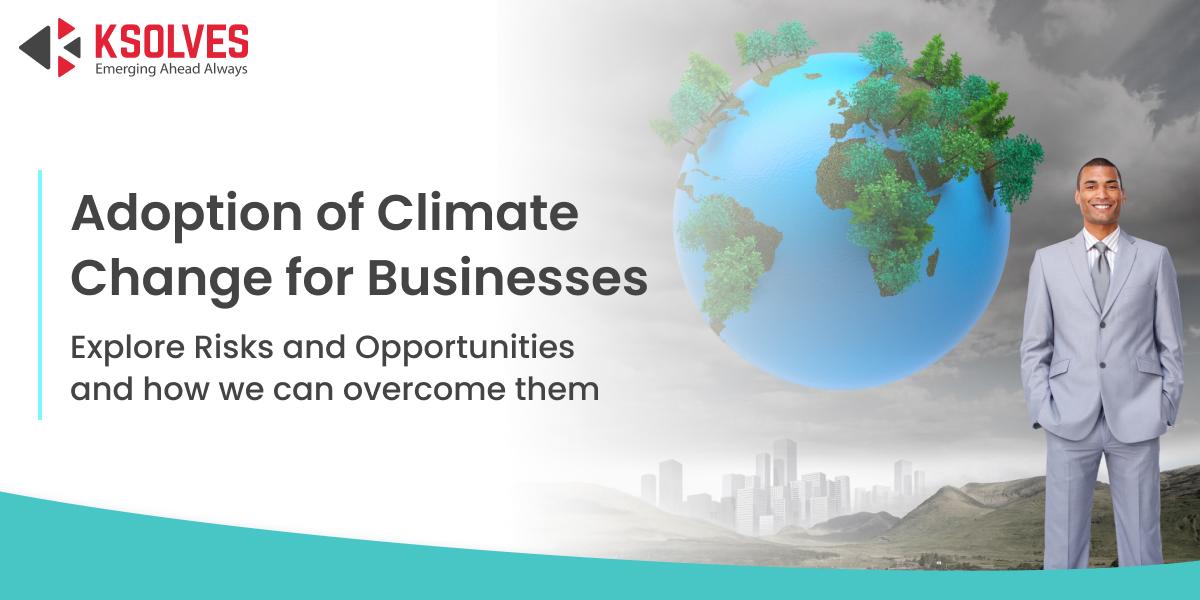Climate Change: Risks and Opportunities for Businesses
Ksolves
5 MIN READ
September 3, 2024
![]()

Climate Change is a reality factor that cannot be ignored and comes with multiple implications that not only impact the environment but also the global economy. The scientific reason behind this is clear and simple which indicates the Earth’s climate is warming. It also depends on human activities such as deforestation, fossil fuel burning, and industrial processes.
As per the research by the Intergovernmental Panel on Climate Change (IPCC), it is found that global temperatures have risen by approximately 1.1°C above pre-industrial levels. The climate change impact is spreading from rising sea levels and melting glaciers to more frequent weather conditions such as floods and wildfires.
However, if we understand things wisely, then it is not only about risks but climate change also comes with a wealth of opportunities for businesses to innovate and adapt. The transition to a low-carbon economy driving new markets and business models from renewable energy to sustainable agriculture. Even the global economy is subjected to exponential growth with the International Energy Agency (IEA) as per the weather conditions. It even predicts that renewables account for around 95% of the increase in global power consumption till 2026.
Let’s move to the sections to understand the climate change risks and explore opportunities that lead to stability.
Climate Change Risks For Businesses
When we talk about businesses, climate change comes with a lot of risks that disturb the firm operations, impact ROI, and scare the long-term growth across industry verticals. These are different risks:
-
Physical Risks
The most substantial risks of climate change are the physical impacts that come from extreme weather events and long-term transitions in the climate. Firms usually face significant challenges and these events cause widespread damage to the infrastructure, disturb supply chain management, and lead to substantial financial losses.
For example, when a flood comes, it becomes difficult for manufacturing companies to manage their business operations and unable to deliver materials on time. In addition, this directly affects the availability and quality of essential resources such as water and raw materials.
-
Regulatory Risks
The government, nowadays, is also there to put efforts into managing climate change to navigate the complex landscape. Multiple new regulations exist in the market that aim at reducing greenhouse gas emissions and promoting sustainability that directly affects costs on companies.
Even failure to comply with the business regulations results in penalties, legal liabilities, and loss of competitiveness. However, as there are multiple regulations out there, businesses that are slow to adapt to the changes find themselves at a lower point when compared to competitors.
-
Reputational Risks
Reputation is everything in today’s marketing world. Consumers and investors only invest in those companies that prioritize the sustainability factor while making investment decisions. In contrast, companies that do not meet the climate change conditions suffer reputational damage that leads to the worst consumer experience.
Moreover, a company’s performance completely depends on its process, its digital communication, and its public experience, this showcases the impact of negative perceptions. Firms then make wise decisions and give a strong commitment to sustainability to enhance their reputation and build stronger relationships with stakeholders.
-
Financial Risks
Finance is another major risk factor that comes under climate change. The major impact of climate change relates to regulatory and reputational challenges that lead to a decline in asset values, particularly for industries related to fossil fuels and exposed to climate-related risks.
When we talk about the insurance industry, we can say that it is grappling with the rising costs of climate-related damages. Many firms face higher insurance premiums in high-risk areas and find it difficult for themselves to secure coverage.
Opportunities Presented by Climate Change
-
Innovation and Technology
Innovation and Technology considered as one of the most exciting opportunities presented by climate change is the innovation potential. As businesses seek to reduce their environmental impact, there is a growing demand for new technologies and solutions that can help mitigate climate risks. Companies that invest in research and development to create sustainable products and services can position themselves as leaders in the green economy.
For example, the renewable energy sector has seen tremendous growth as companies and governments alike seek alternatives to fossil fuels. Businesses involved in the development of solar, wind, and other renewable energy technologies are not only contributing to climate solutions but also capitalizing on a rapidly expanding market.
-
Market Differentiation
Climate change offers businesses an opportunity to differentiate themselves in the marketplace. By adopting sustainable practices and demonstrating a commitment to environmental stewardship, companies can attract eco-conscious consumers and investors. This can translate into increased brand loyalty, higher sales, and access to new markets.
Businesses that prioritize sustainability are also more likely to build resilient supply chains, reduce their dependence on volatile resources, and foster long-term relationships with stakeholders. This can provide a competitive edge in an increasingly sustainability-driven economy.
-
Reduce Costs
While comparison with sustainability always comes with a high price tag, many businesses are finding that adopting eco-friendly practices can lead to significant cost savings. Reducing energy consumption, minimizing waste, and improving resource efficiency can lower operating costs and improve profitability over the long term.
For example, companies that invest in energy-efficient technologies or transition to renewable energy sources often experience reduced utility bills. Similarly, implementing sustainable supply chain practices can minimize waste and reduce costs associated with raw materials and logistics.
-
Regulatory Incentives
Governments around the world are offering various incentives to encourage businesses to adopt sustainable practices. These incentives can take the form of tax credits, grants, or subsidies for investments in renewable energy, energy efficiency, and other green initiatives. Businesses that take advantage of these incentives can lower their capital costs and accelerate the adoption of sustainable technologies.
In addition to direct financial incentives, companies that lead in sustainability may also benefit from preferential treatment in public procurement, enhanced access to financing from green investment funds, and improved relations with regulators.
How Can Businesses Adapt and Thrive Amidst Climate Risks?
As the realities of climate change become more apparent, businesses are finding themselves at a crossroads. The question isn’t just about how to survive but how to thrive in a world where climate risks are an ever-present concern. Here’s how companies are navigating these challenges:
-
Weaving Climate Risk into Business Strategy
Smart companies are no longer treating climate change as an afterthought. They’re putting it right at the heart of their business strategy. This means taking a hard look at how climate risks could impact everything from daily operations to long-term financial health and then making the necessary adjustments. By planning for various climate scenarios, they ensure that they’re ready for anything nature might throw their way.
-
Investing in Green Technologies
Reducing carbon footprints and boosting resilience have become business priorities. Companies are pouring money into green technologies like renewable energy, energy-efficient systems, and sustainable infrastructure. Whether it’s installing solar panels or upgrading to energy-saving equipment, these investments are helping businesses cut costs and stay compliant with new regulations.
-
Engaging in Social Responsibility
More businesses are realizing the power of corporate social responsibility (CSR) in the fight against climate change. By getting involved in initiatives like reforestation, waste reduction, and sustainable practices, they’re doing their part for the planet and enhancing their reputation. This kind of engagement can attract customers and investors who value environmental stewardship.
-
Using Data to Manage Risks
In today’s data-driven world, companies use advanced analytics to stay ahead of climate risks. Businesses can predict potential disruptions and make smarter decisions by analyzing data on weather patterns, resource use, and other factors. Tools like big data and AI are helping them pinpoint vulnerabilities and respond quickly to challenges.
-
Innovating in Products and Services
Climate change is pushing businesses to rethink their offerings. Companies that develop sustainable products or services are tapping into a growing market of eco-conscious consumers. Whether it’s creating products with less packaging or launching services that help others reduce their carbon footprint, innovation in this area is opening new doors and setting companies apart from the competition.
How Does Ksolves Help You With Climate Change Opportunities?
With years of expertise, Ksolves helps businesses navigate climate change opportunities by offering cutting-edge technology solutions and strategic consulting tailored to sustainability and resilience.
What Ksolves Do?
-
Custom Software Development for Green Innovation
Ksolves develops customized software solutions that enable businesses to innovate in green technology. Whether it’s creating applications for renewable energy management, smart grids, or sustainable supply chains, Ksolves’ expertise in software development helps companies stay ahead in the green economy.
-
Data Analytics for Informed Decision-Making
With advanced data analytics and AI solutions, Ksolves enables businesses to analyze climate-related data, predict trends, and make informed decisions. This helps companies identify new market opportunities, optimize resource use, and reduce environmental impact.
-
Cloud Computing for Energy Efficiency
Ksolves provides cloud solutions that help businesses reduce their carbon footprint. By migrating to cloud infrastructure, companies can achieve greater energy efficiency, lower costs, and enhanced scalability, contributing to their overall sustainability goals.
-
Compliance and Reporting Tools
Ksolves develops tools to help businesses comply with environmental regulations and standards. These solutions facilitate real-time reporting, monitoring, and documentation, ensuring companies meet regulatory requirements and avoid penalties while enhancing their reputation.
-
Digital Transformation for Sustainability
Ksolves drives digital transformation initiatives that align with sustainability objectives. By integrating eco-friendly practices into business processes through technology, Ksolves helps companies transition smoothly to a low-carbon economy while maintaining competitiveness.
Conclusion
Climate change presents both risks and opportunities for businesses. While the challenges are significant, businesses that proactively address these risks and seize the opportunities can not only protect themselves from the adverse effects of climate change but also position themselves as leaders in the transition to a more sustainable economy. By investing in innovation, embracing sustainability, and leveraging regulatory incentives, companies can turn climate risks into a source of competitive advantage and long-term success.
![]()




Author
Share with